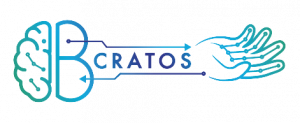B-CRATOS at the Annual Meeting of the Society for Neuroscience 2024
In October 2024, our partners from DPZ participated at the Society for Neuroscience in Chicago. It was a great opportunity for them to share their research and experience with scientists from all over the world.
The poster they presented was Training of real-time robotic grasp decoding from neuronal population activity in macaque motor cortex (M1). It concerned with the primate cortex which can be viewed as a closed-loop dynamical system with very high dimensionality. Extracting a sub-sample of this activity and using it for the decoding of any encoded intention is a challenging task by virtue of the size of the sample relative to the full population. The problem is amplified by the brain’s plasticity, which renders any effort towards decoding ephemeral.
Here they employed a modified Kalman filter to decode the grip of a robotic hand from population spiking activity recorded from two 64 channel Utah arrays implanted in the hand area of primary motor cortex (area M1) of a macaque monkey. Their results confirm that a modified Kalman Filter is suitable to successfully translate cortical activity to motor commands of a robot hand in real time. They also demonstrate the gradual learning by observation and internalization of the task by the monkey using two metrics – the reduction in the transitory nature of the decoder and the speed of the transfer of control of the prosthesis to the monkey. In early experimental sessions, the monkey was slow to take over control and the decoder required retraining within the experiment session, whereas in later sessions decoder training was required only at the beginning of the session and transfer of control was rapid. Furthermore, decoder training involved not only the training of the decoder on the neural activity, but it also adapted brain activity on the decoder, and an equilibrium had to be maintained between the learning processes. This equilibrium was achieved faster and maintained more robustly as the monkey became more proficient in the task, hence demonstrating the viability of this learning-by-observation paradigm.



Leave a Reply
Want to join the discussion?Feel free to contribute!